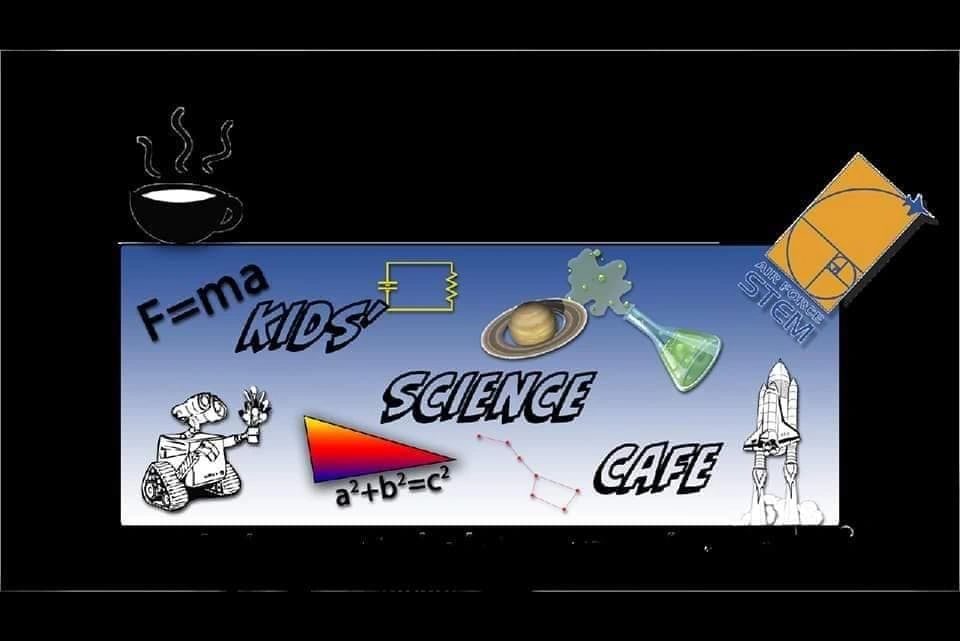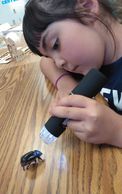
Breaking ground on the Klinglesmith Children's Observatory.
The Kids' Science Cafe', where you go to order a desire, a dream, or a career.
This Web Site was made by a kid.

The Kids' Science Cafe', where you go to order a desire, a dream, or a career.
This Web Site was made by a kid.
The Kids' Science Cafe' is an after school, out of school, STEM (Science, Technology, Engineering and Mathematics) educational outreach non-profit organization. It is designed to support the development of educational skillsets of K-12 aged youth. Our instructional models are based on Discovery, Investigation, and Experiential Instructional Methodologies. We currently offer a primary program (5 to 12 years of age), a secondary program (13 to 17 years of age) and run 3 summer week long activities in aviation, space and geoscience. Our staff are current or former teachers.













This is what we do when we first come in:
1) We take our temperature.
2) We ask people how they are feeling.
3) We wash with soap, water, or hand sanitizer.
4) We wash our tables and stations with cleaners.
5) We follow the rules the Governor says.

1) Our teachers tell us how bacteria and virus work.
2) We learn how CoVid-19 is bad for us and why we must follow the rules.
3) We learn about chemistry and make hand sanitizer and spray cleaners that kill bacteria and virus stuff.
4) The formulas that we use are the ones scientists say are good to use.

Your support will help us learn new things by allowing us to explore, discover, and experience .
Possession or use of illicit drugs or medications is not allowed at, or on the grounds of the Kids' Science Cafe'. This organization provides classes/training along a four prong approach with the standard and objective of:
Short weekly classes are conducted to help children learn how to:
Showing youth that there are active and passive modes that result in prevention. These include practices that result in:
There are positive and negative ways to say "No." If we pay attention to our situation and the conditions that surround the circumstance, we can:
202 Spruce Steet
Young Engineers and Scientists experience NASA/JPL operations where design, coding, and vehicle operations are concerned.
202 Spruce Steet
202 Spruce Street
Currently, "Cafers" are working with the New Mexico Tech Geology Department, conducting Water Quality Research. We have upcoming activities...
202 Spruce Street
202 Spruce Street
10:00-11:45 1st Scheduled Instruction and Investigation/Activity
11:45-12:00 Lunch
12:00-1:00 Coding and Programming (Group 1)
...
202 Spruce Street

Seeing a need to renew education interests in science and engineering, the Kids' Science and Teen Science Cafe's were organized to support youth between the ages of 5 and 17.

Student Stated:
Our mission is to make our generation solve new the problems.
Non-Profit Mission Statement:
Provide out of school individual and group learning opportunities for the children of Magdalena Village and surrounding communities in a wide range of organized/managed exploratory, discovery and experiential activities specifi
Student Stated:
Our mission is to make our generation solve new the problems.
Non-Profit Mission Statement:
Provide out of school individual and group learning opportunities for the children of Magdalena Village and surrounding communities in a wide range of organized/managed exploratory, discovery and experiential activities specific to Science, Engineering, Art, Technology and Mathematics (STEAM).

High interest activities are used to show young scientists and engineers what they can accomplish. Currently, we engage youth in aviation instruction, introduction to aerospace operations, and research in the field of geoscience.

This is where we use microscopes. We have microscopes that hook up to the computer and others us you alone. I never knew beetles had hair.

We build plastic models and rockets at the Kids' Science Cafe'. Our rockets even fly. As we learn how, we get to use motors that make our rockets go faster. Mr. Sauer says we can learn how to fly remote control airplanes if we want to learn.

Sometimes Dean Crane comes to teach us about rocks. We all started rock collections. We have a rock polisher, a pottery wheel and and rock grinder. Ms. Nina uses a kiln to turn our clay into glass. We use the rock grinders and polisher to make jewelry.
Mr. Sauer says when we grow up, to get even an ok job we will have to know how to code. So we do Lego, RoboRave, and now we have coding at the Magdalena Libary with Ms. Ivy.

Ms Brunson used to teach at Magdalena School. Now she teaches us chemistry at the cafe'. So far, we have made chemicals that keep mosquitoes from biting, anti-itch balm, perfume, and hand sanitizer to fight CoVid. Soon, we will learn how to make a spray that kills bacteria and virus.

The Kids' Science Cafe' was recommended by staff from the USAF Research Laboratory STEM Outreach Directorate to work with NASA on a student driven sensor research program.

Our young engineers underwent 12 hours of instruction pertaining to history, policy, and procedure. They now employ equipment weekly obtaining electronic data which they report.

NASA / AREN provided us with a piece of equipment called an AeroKat. It has a camera on it. We added a PocketLab to it too. Every time we fly, we get at least 1,000 pictures like this one. We try to find different places to fly. This is on Magdalena Ridge. The altitude here is 10,500 feet.

The Klinglesmith Observatory is an observatory for kids. The observatory is located at the Kids' Science Cafe' and was built in memory of Dr. Dan Klinglesmith as NASA and NMT Astrophysicist.

We had contractors come and help. They gave us a lesson about concrete and then let the kids smooth and pour the concrete. We raised the money to pay for this by selling cookies and popcorn at the Magdalena Car Show. We also got a lot of donations from nice people.

After the foundation, we poured a porch and put our names on it. We even put Dr. Dan's and Ms. Gerry's.

We used donations to buy the dome ring and dome roof. The dome was given to us by Mr. John of the Magdalena Astronomical Society while Mr. and Ms. Pody provided the telescope pedestal. We built the roof and dome ourselves.

With the exception of trim, wiring, and painting, construction is finished. The Klinglesmith Astronomical Observatory for Children is the first such in New Mexico and thought to be the first for youth in the United States.

The interior has two activity centers. First, the observatory itself with the star charts, telescope and other references required for viewing the planets, moon, and stars. The second section is a high interest activity zone which which incorporate discovery, investigation, and experiential tasks designed to motivate and focus on space related tasks/skill-sets.

The Mayor of Magdalena has asked that the Kids' Science Cafe' conduct NASA/AREN Photographic Flights over the Magdalena Cemetery in an effort to identify possible unmarked grave sites.

As active participants in the NASA/AREN program, young engineers and scientists use kite platforms to monitor weather and take pictures.

This is an AeroKat. It has a camera and a PocketLab Weather Sensor attached. One picture per second is taken. Weather data is taken one time per minute.

Two people launch the 7th foot Delta Kite while another launches the AeroKat Sensor.

Today, we flew 3 altitudes. From the pictures we will decide how high we should fly in order to see where people are buried and where others might be burred. We are being taught how to do photo-interpretation. You can see some graves. Can you see where there might be others?

After we accomplish our mission for the day, we recover the AeroKat and the Delta Kite.

An Education Organization approached the Kids' Science Cafe' with an opportunity to study an aspect of Environmental Science through deployment of rockets and high altitude balloons. This will allow kids to meet and work with scientists and engineers.

Right now, we are testing scale rockets to see how high they go and how long we can keep them up there. The rockets keep getting bigger. We have a Jolly Logic altimeter in the rocket that tells us all about the rocket flight.

A kid in Nevada is building and coding a sensor that will tell us about the weather. We will send this into the air in the nose cone of the rocket or on the instrumentation tray of the balloon.

We built, launched, tracked, and recovered a high altitude balloon. It traveled to more than 120,000 feet and took video.

We completed our first year of the GeoScience Program. As a part of this instruction, we learned about weather, how lightning is made, what it is like to live and work at high altitude (10,500 feet), and what plants and animals live up here. Living and doing the work of an actual scientist is incredible.

Do you have questions?





















Science Kids learning photography.
Sign up to hear from us about special events and what we are up to.



































